Information injection-pump assembly
ZEXEL
106681-4242
1066814242
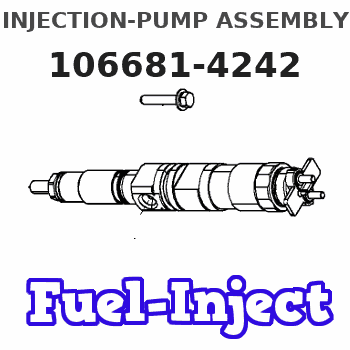
Rating:
Service parts 106681-4242 INJECTION-PUMP ASSEMBLY:
1.
_
7.
COUPLING PLATE
8.
_
9.
_
11.
Nozzle and Holder
35A61-00010
12.
Open Pre:MPa(Kqf/cm2)
21.6{220}
15.
NOZZLE SET
Include in #1:
106681-4242
as INJECTION-PUMP ASSEMBLY
Cross reference number
ZEXEL
106681-4242
1066814242
Zexel num
Bosch num
Firm num
Name
106681-4242
INJECTION-PUMP ASSEMBLY
Calibration Data:
Adjustment conditions
Test oil
1404 Test oil ISO4113 or {SAEJ967d}
1404 Test oil ISO4113 or {SAEJ967d}
Test oil temperature
degC
40
40
45
Nozzle and nozzle holder
105780-8130
Bosch type code
EFEP215A
Nozzle
105780-0050
Bosch type code
DN6TD119NP1T
Nozzle holder
105780-2090
Bosch type code
EFEP215
Opening pressure
MPa
17.2
Opening pressure
kgf/cm2
175
Injection pipe
Outer diameter - inner diameter - length (mm) mm 8-4-1000
Outer diameter - inner diameter - length (mm) mm 8-4-1000
Overflow valve
131424-3420
Overflow valve opening pressure
kPa
255
221
289
Overflow valve opening pressure
kgf/cm2
2.6
2.25
2.95
Tester oil delivery pressure
kPa
157
157
157
Tester oil delivery pressure
kgf/cm2
1.6
1.6
1.6
Direction of rotation (viewed from drive side)
Left L
Left L
Injection timing adjustment
Direction of rotation (viewed from drive side)
Left L
Left L
Injection order
1-5-3-6-
2-4
Pre-stroke
mm
2.8
2.75
2.85
Rack position
Point A R=A
Point A R=A
Beginning of injection position
Governor side NO.1
Governor side NO.1
Difference between angles 1
Cal 1-5 deg. 60 59.5 60.5
Cal 1-5 deg. 60 59.5 60.5
Difference between angles 2
Cal 1-3 deg. 120 119.5 120.5
Cal 1-3 deg. 120 119.5 120.5
Difference between angles 3
Cal 1-6 deg. 180 179.5 180.5
Cal 1-6 deg. 180 179.5 180.5
Difference between angles 4
Cyl.1-2 deg. 240 239.5 240.5
Cyl.1-2 deg. 240 239.5 240.5
Difference between angles 5
Cal 1-4 deg. 300 299.5 300.5
Cal 1-4 deg. 300 299.5 300.5
Injection quantity adjustment
Adjusting point
A
Rack position
13.6
Pump speed
r/min
1000
1000
1000
Average injection quantity
mm3/st.
405
397
413
Max. variation between cylinders
%
0
-3
3
Basic
*
Fixing the rack
*
Boost pressure
kPa
123
123
Boost pressure
mmHg
920
920
Injection quantity adjustment_02
Adjusting point
C
Rack position
6.8+-0.5
Pump speed
r/min
350
350
350
Average injection quantity
mm3/st.
22
19
25
Max. variation between cylinders
%
0
-10
10
Fixing the rack
*
Boost pressure
kPa
0
0
0
Boost pressure
mmHg
0
0
0
Boost compensator adjustment
Pump speed
r/min
600
600
600
Rack position
R1-3.2
Boost pressure
kPa
46.7
44
49.4
Boost pressure
mmHg
350
330
370
Boost compensator adjustment_02
Pump speed
r/min
600
600
600
Rack position
R1(15.2)
Boost pressure
kPa
109
102.3
115.7
Boost pressure
mmHg
820
770
870
Timer adjustment
Pump speed
r/min
(N1+50)-
-
Advance angle
deg.
0
0
0
Remarks
Start
Start
Timer adjustment_02
Pump speed
r/min
N1
Advance angle
deg.
0
0
0
Remarks
Measure the actual speed.
Measure the actual speed.
Timer adjustment_03
Pump speed
r/min
-
Advance angle
deg.
4
3.5
4.5
Remarks
Measure the actual speed, stop
Measure the actual speed, stop
Test data Ex:
Governor adjustment
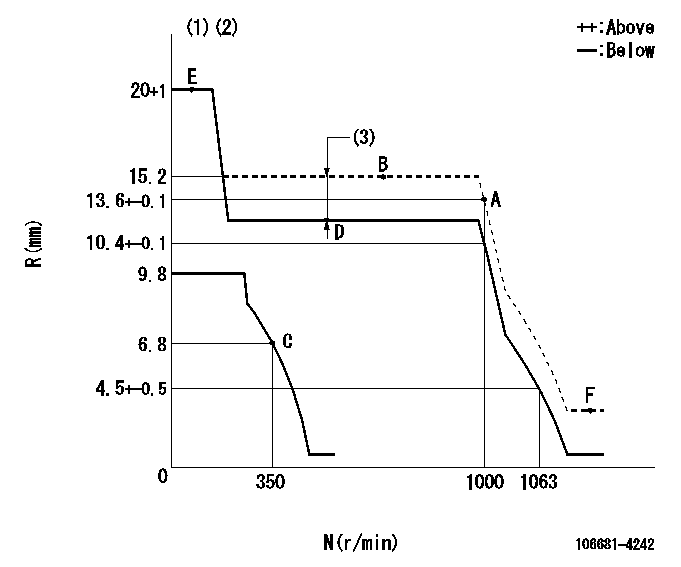
N:Pump speed
R:Rack position (mm)
(1)Target notch: K
(2)Tolerance for racks not indicated: +-0.05mm.
(3)Boost compensator stroke: BCL
----------
K=12 BCL=3.2+-0.1mm
----------
----------
K=12 BCL=3.2+-0.1mm
----------
Speed control lever angle
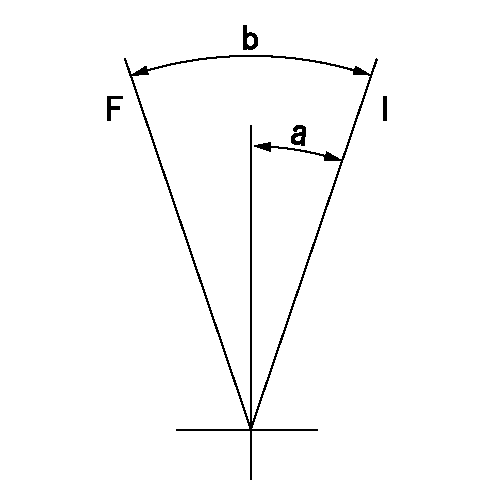
F:Full speed
I:Idle
----------
----------
a=19deg+-5deg b=33deg+-5deg
----------
----------
a=19deg+-5deg b=33deg+-5deg
Stop lever angle
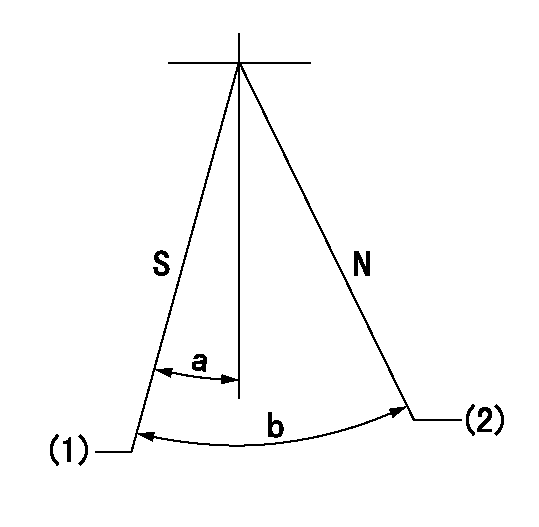
N:Pump normal
S:Stop the pump.
(1)Pump speed aa, rack position bb
(2)Normal
----------
aa=0r/min bb=1-0.5mm
----------
a=33deg+-5deg b=(73deg)
----------
aa=0r/min bb=1-0.5mm
----------
a=33deg+-5deg b=(73deg)
Timing setting
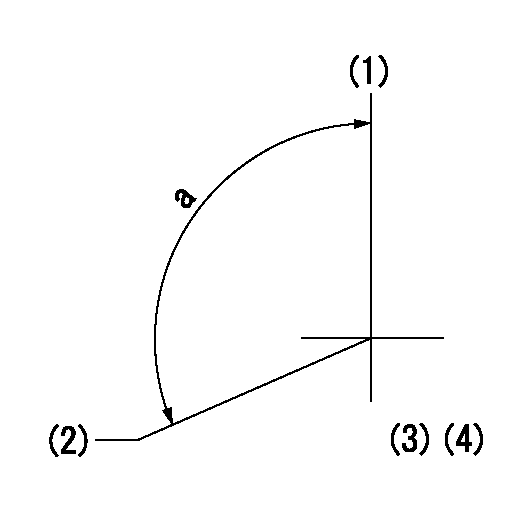
(1)Pump vertical direction
(2)Coupling's key groove position at No 1 cylinder's beginning of injection
(3)-
(4)-
----------
----------
a=(110deg)
----------
----------
a=(110deg)
Information:
Delco-Remy Alternator; Pulley Nut Tightening
Tighten nut holding the pulley to a torque of 75 5 lb. ft. (100 7 N m) with the tools shown.
ALTERNATOR PULLEY INSTALLATION
1. 8S1588 Adapter (1/2" female to 3/8" male). 2. 8S1590 Socket (5/16" with 3/8" drive). 3. 1P2977 Tool Group. 8H8555 Socket (15/16" with 1/2" drive) not shown.Alternator Regulator Adjustment (Delco-Remy)
Set Screw Type
When an alternator is charging the battery too much or not enough, an adjustment can be made to the charging rate of the alternator. Remove the hollow head screw (1) from the alternator and use a screwdriver to turn the adjustment screw. Turn the adjustment screw one or two notches to increase or decrease the charging rate of the alternator.
LOCATION OF ADJUSTMENT SCREW FOR THE ALTERNATOR REGULATOR
1. Hollow head screw. 2. Connector.Cap Type
ALTERNATOR REGULATOR ADJUSTMENT
1. Voltage adjustment cap.When the alternator is either charging the battery too much or not enough, an adjustment can be made to the alternator charging rate. To make an adjustment to the voltage output, remove the voltage adjustment cap (1) from the alternator, turn the cap 90°, and install it again into the alternator. The voltage adjustment cap has four positions: HI, LO, and two positions between the high and the low setting.Alternator Regulator (Prestolite)
ALTERNATOR REGULATOR
1. Adjustment screw with washer. 2. High output position. 3. Green wire to field terminal of the alternator (F). 4. Orange wire to battery. 5. Black wire to ground.The regulator components are sealed in an insulation of epoxy. The regulator is an electronic component with no moving parts (solid state) and has an adjustment screw (1) on the back. This voltage adjustment screw is used to meet different operating needs at different times of the year. An increase or decrease by .5 volts from the normal (N) setting is made by removing the regulator and changing the position of the adjustment screw and washer. An increase to the voltage will be made by moving the screw and washer to the "H" position (2).Starting System
5P300 Electrical Tester. Make reference to Special Instruction Form No. SEHS7006 and to the instructions inside of the cover of the tester, when testing with the 5P300 Electrical Tester.Use a D.C. Voltmeter to find starting system components which do not function.Move the starting control switch to activate the starter solenoid. Starter solenoid operation can be heard as the pinion of the starter motor is engaged with the ring gear on the engine flywheel. The solenoid operation also closes the electric circuit to the motor. Connect one wire of the voltmeter to the solenoid connection (terminal) that is fastened to the motor. Connect the other wire to a good ground. Activate the starter solenoid and look at the voltmeter. A reading of battery voltage shows the problem is in the motor. The motor must be removed for more testing. No reading on the voltmeter shows that the solenoid contacts do not close. This is an indication of the need for repair to the solenoid or of an adjustment
Tighten nut holding the pulley to a torque of 75 5 lb. ft. (100 7 N m) with the tools shown.
ALTERNATOR PULLEY INSTALLATION
1. 8S1588 Adapter (1/2" female to 3/8" male). 2. 8S1590 Socket (5/16" with 3/8" drive). 3. 1P2977 Tool Group. 8H8555 Socket (15/16" with 1/2" drive) not shown.Alternator Regulator Adjustment (Delco-Remy)
Set Screw Type
When an alternator is charging the battery too much or not enough, an adjustment can be made to the charging rate of the alternator. Remove the hollow head screw (1) from the alternator and use a screwdriver to turn the adjustment screw. Turn the adjustment screw one or two notches to increase or decrease the charging rate of the alternator.
LOCATION OF ADJUSTMENT SCREW FOR THE ALTERNATOR REGULATOR
1. Hollow head screw. 2. Connector.Cap Type
ALTERNATOR REGULATOR ADJUSTMENT
1. Voltage adjustment cap.When the alternator is either charging the battery too much or not enough, an adjustment can be made to the alternator charging rate. To make an adjustment to the voltage output, remove the voltage adjustment cap (1) from the alternator, turn the cap 90°, and install it again into the alternator. The voltage adjustment cap has four positions: HI, LO, and two positions between the high and the low setting.Alternator Regulator (Prestolite)
ALTERNATOR REGULATOR
1. Adjustment screw with washer. 2. High output position. 3. Green wire to field terminal of the alternator (F). 4. Orange wire to battery. 5. Black wire to ground.The regulator components are sealed in an insulation of epoxy. The regulator is an electronic component with no moving parts (solid state) and has an adjustment screw (1) on the back. This voltage adjustment screw is used to meet different operating needs at different times of the year. An increase or decrease by .5 volts from the normal (N) setting is made by removing the regulator and changing the position of the adjustment screw and washer. An increase to the voltage will be made by moving the screw and washer to the "H" position (2).Starting System
5P300 Electrical Tester. Make reference to Special Instruction Form No. SEHS7006 and to the instructions inside of the cover of the tester, when testing with the 5P300 Electrical Tester.Use a D.C. Voltmeter to find starting system components which do not function.Move the starting control switch to activate the starter solenoid. Starter solenoid operation can be heard as the pinion of the starter motor is engaged with the ring gear on the engine flywheel. The solenoid operation also closes the electric circuit to the motor. Connect one wire of the voltmeter to the solenoid connection (terminal) that is fastened to the motor. Connect the other wire to a good ground. Activate the starter solenoid and look at the voltmeter. A reading of battery voltage shows the problem is in the motor. The motor must be removed for more testing. No reading on the voltmeter shows that the solenoid contacts do not close. This is an indication of the need for repair to the solenoid or of an adjustment
Have questions with 106681-4242?
Group cross 106681-4242 ZEXEL
106681-4242
INJECTION-PUMP ASSEMBLY